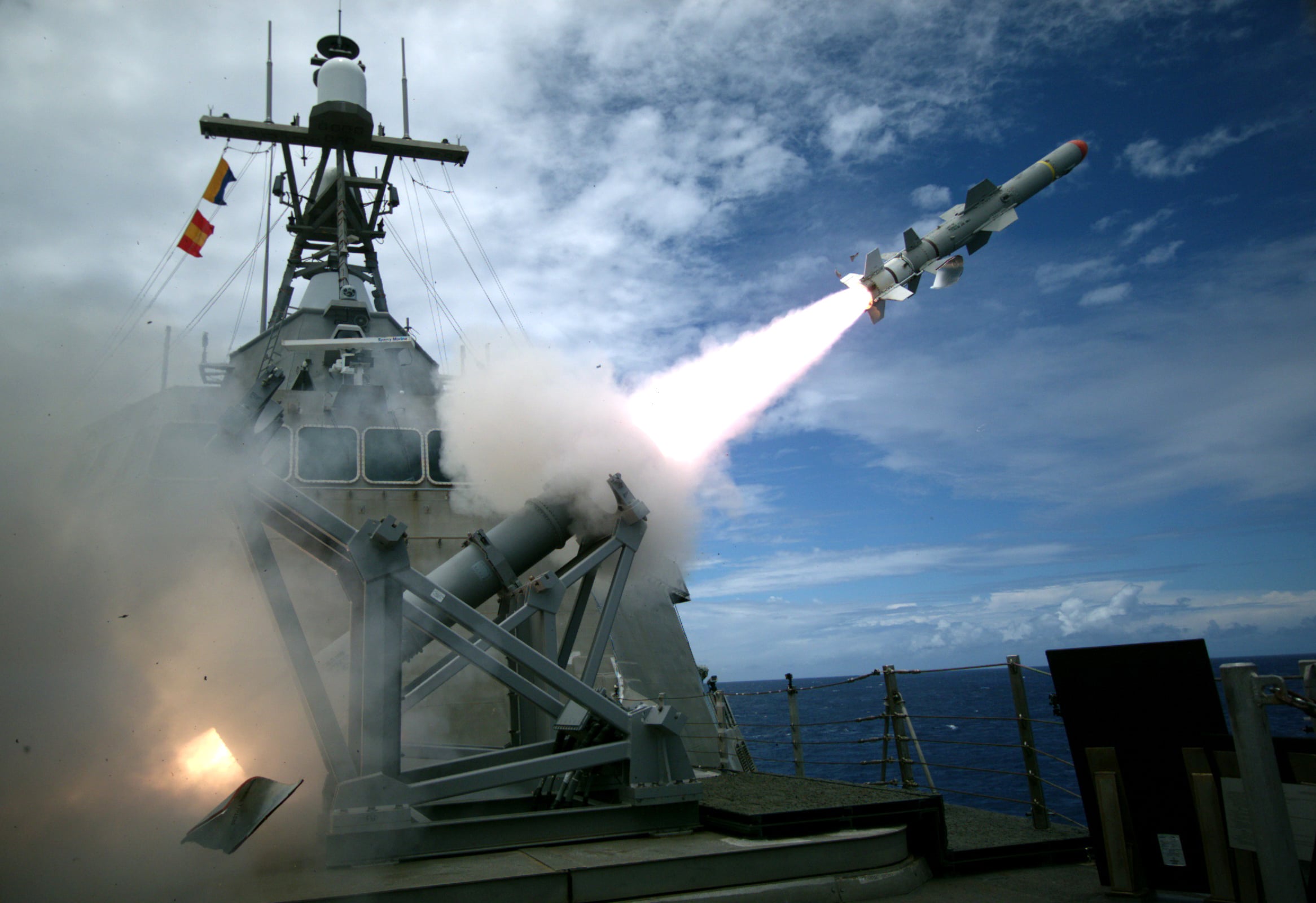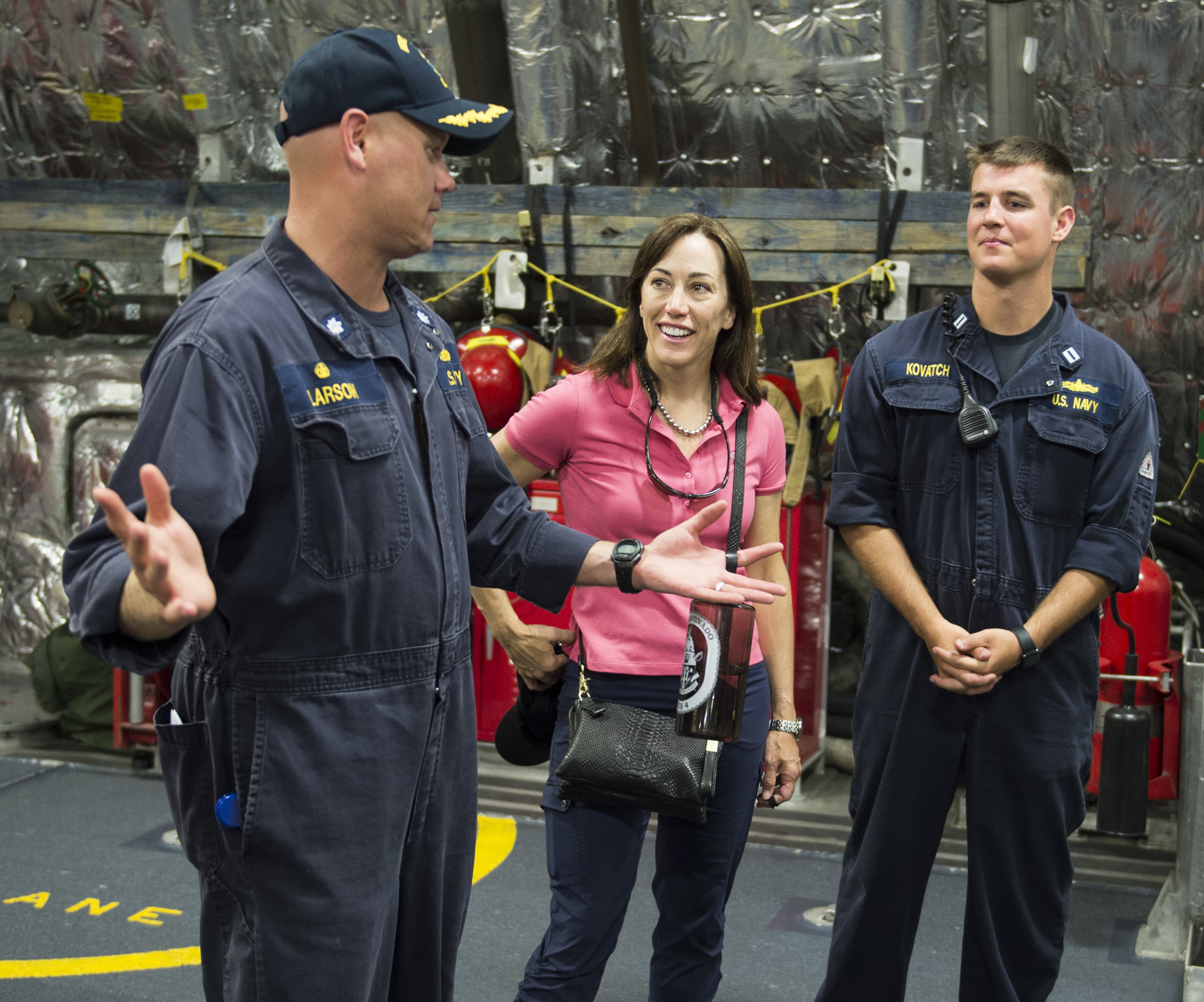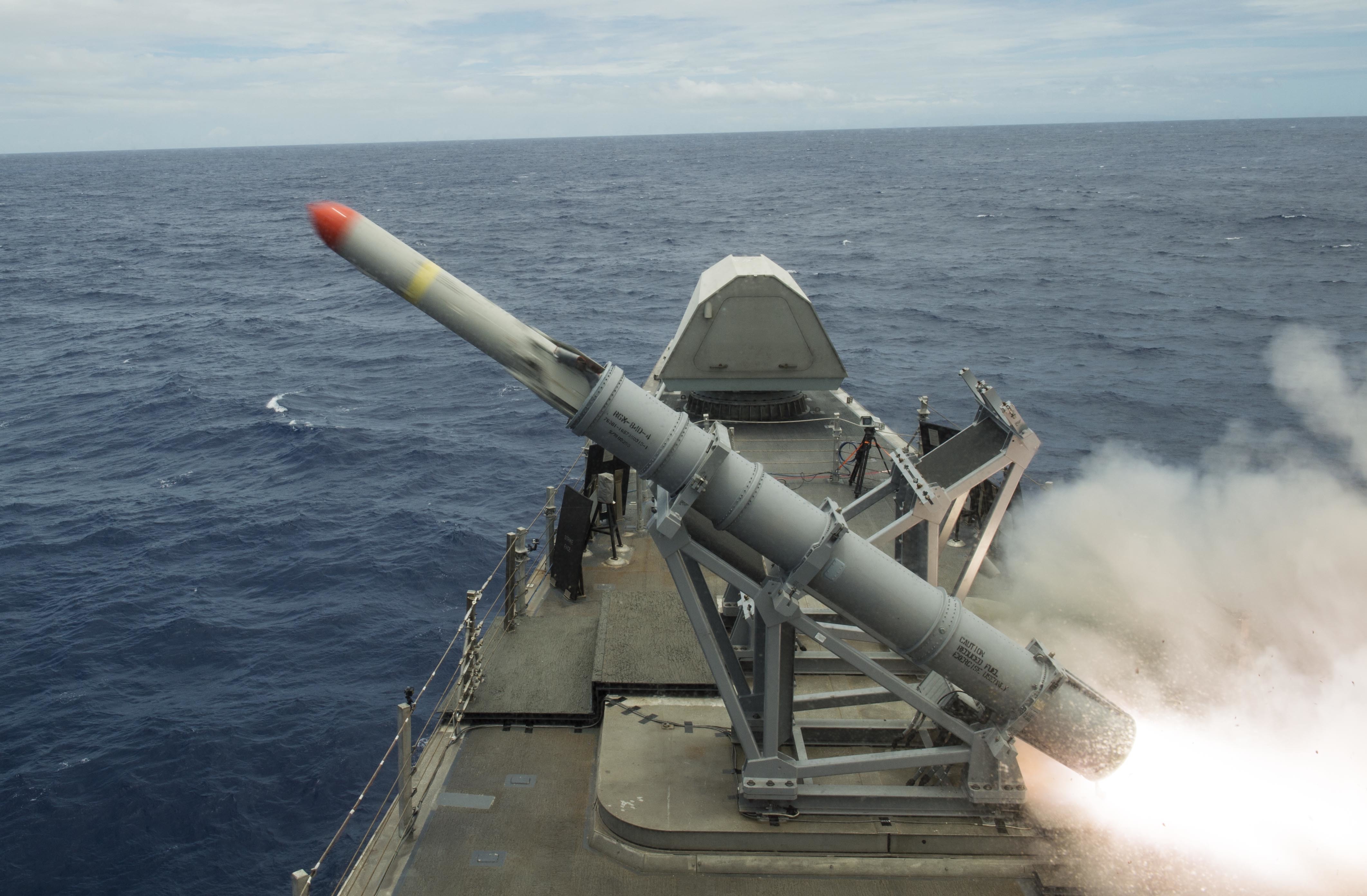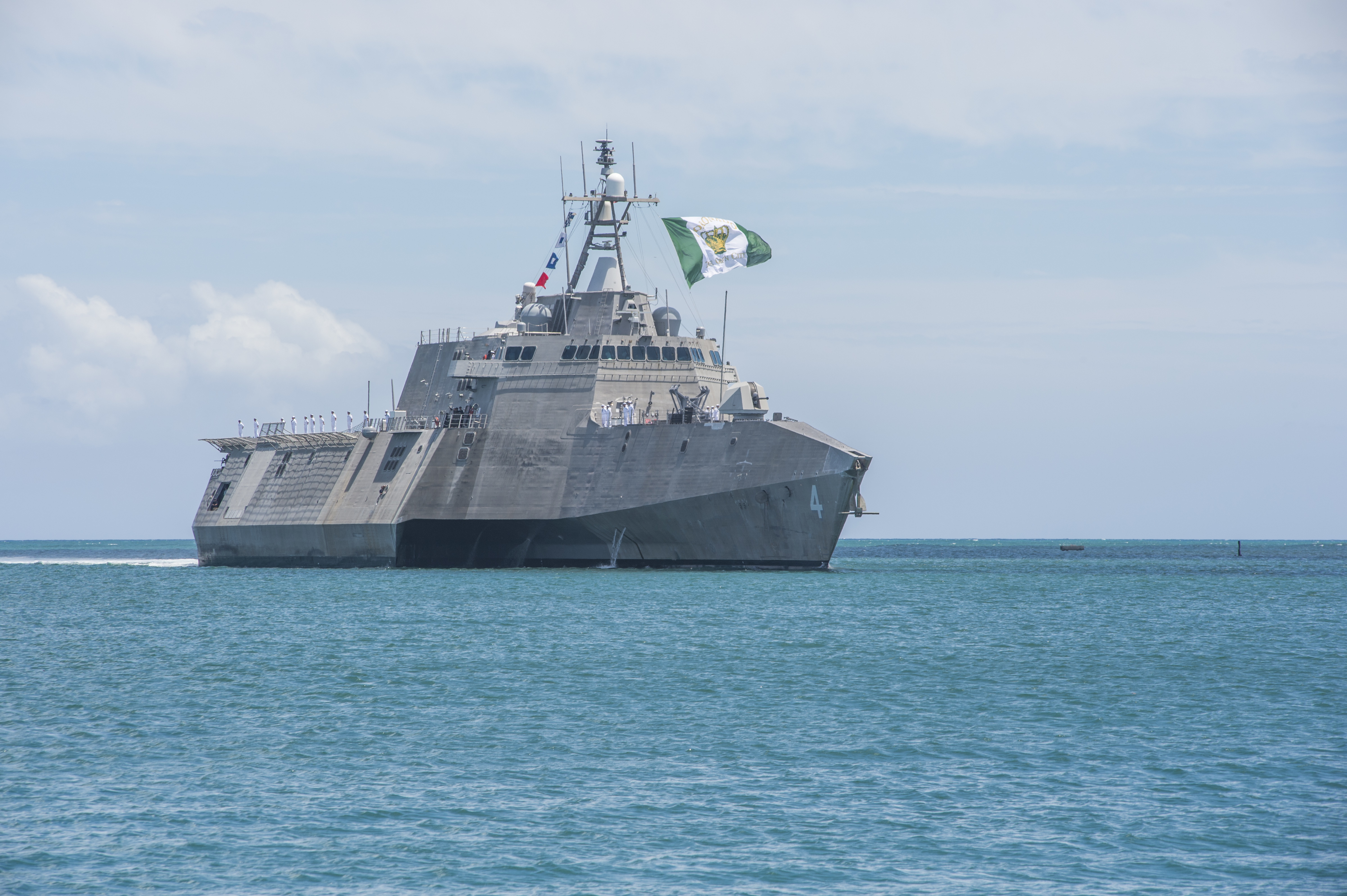
PEARL HARBOR, Hawaii – The Littoral Combat Ship USS Coronado (LCS-4) has had an opportunity to work with Chinese ships and naval crews during the Rim of the Pacific 2016 exercise and develop an understanding with their counterparts ahead of the ship’s maiden deployment to U.S. 7th Fleet, which will almost certainly include spending time patrolling the South China Sea.
Cmdr. Scott Larson, commanding officer of Coronado and LCS Crew 204, told USNI News in a phone interview from his ship at sea Wednesday that the Chinese navy has been professional and helpful during the multinational biennial exercise. He said he attended a reception aboard a Chinese ship during the harbor phase early in the exercise, and “they’ve been a warm and welcoming audience since I’ve been here.”
“My boarding team, my (visit, board, search and seizure) boarding team spent some time over on one of their frigates several days ago, and they were treated exceptionally well, they were welcomed onboard,” Larson said.
“The level of partnership I’ve seen so far has actually exceeded my expectations, and I feel it’s been a mutually productive exercise. We’ve gotten to learn a little bit about how they operate and develop some of those useful insights that I’m sure will pay dividends once we get over to 7th Fleet. But then they’ve also been able to develop a sense of comfortability and understanding as to how we operate. So their participation has really been no different than the participation that I’ve see from other maritime partners and participating countries that we’ve worked with out here.”
Larson said there has been great international interest in his ship because “we are the shiny new object,” and he said the sailors of LCS Crew 204 – the ship’s commissioning crew – haven’t grown tired of showing off their ship.

Coronado sailed to Hawaii for RIMPAC as part of a multinational task force, which used the voyage from San Diego to practice close formation maneuvering, main battery gun firing, professional exchanges and VBSS drills. Larson said he worked primarily with the Canadian frigate HMCS Calgary (FFH-335), and since arriving in Hawaii he has done similar tasks with Chinese, Japanese and Indonesian navies, as well as counter-piracy work with the French navy. Some of these tasks have been new for LCS, while others have been good real-world practice ahead of the maiden deployment.
“Multinational counter-piracy and maritime interdiction, I wouldn’t classify that as a new capability but definitely flexed that to a large extent out here with our partner navies,” Larson said.
“Anti-FAC/FIAC (fast attack craft /fast inshore attack craft) and small boat defense, we’ve flexed some tactics in that area and I think we’ve developed a better understanding as to how some of our partners and how we execute that mission. Integrating special operations forces, I think that is somewhat of a new capability but there’s definitely a lot of growth potential for integration – not just within our own service with special operations forces, but there’s also been some keen interest on the part of the Marine Corps to see what possible platforms of cooperation might exist between LCS and the Marine Corps and other joint partners because of our payload capacity and some of the flexibility that we offer in terms of our reconfigurability. There’s a lot of interest there.
“Search and rescue, we’re going to be flying the MQ-8B Fire Scout, the unmanned helicopter, here pretty aggressively over the next several days, so that’s a unique capability that was not part of RIMPAC 2014, at least on the LCS side,” Larson continued.
“So we’ll be showcasing that and I think that’s going to get people’s attention.”
Most obvious of the new capabilities, though, was the Harpoon Block 1C over-the-horizon missile launch on July 19.

From 20 nautical miles away at the Pacific Missile Range Facility, Coronado aimed to sink the ex-USS Crommelin (FFG 37), “which just happens to be my old ship,” Larson said. The missile ultimately missed the decommissioned frigate, but Larson said the structural test firing to prove the concept of an LCS-2 firing a Harpoon was a success.
“The missile left the canister and appeared to be going down the correct firing bearing. We visually observed booster separation shortly after the missile flew out, and after that we lost radar contact,” he said.
“It is assessed at this point that it was a negative impact, but there is still a lot of data collection and analysis that is taking place both at the range facility as well as [Naval Surface Warfare Center] Corona to determine what may have happened to the missile while it was in flight.”
“So it wasn’t a hit,” he said, but the test objectives were successfully achieved. Data recorders were placed on the ship to assess the impact, and initial assessments and follow-on inspections showed no structural damage or failures after the missile was launched – a missile that is generally fired from ships larger than the LCS.
Despite the smaller ship absorbing the energy from the launch, “it actually felt very normal,” Larson said.
“The impact essentially was there was no impact. It felt like any other missile launch I’ve done on any other platform that I’ve served on.”
Larson said despite the miss, the ship would outfitted with two Harpoon missiles for each of the two launchers when the ship departs Pearl Harbor for its maiden deployment.
“To me it’s just very motivating to be able to demonstrate to the fleet what the LCS-2 variant brings to the fight,” Larson said of the deployment, which will officially begin after RIMPAC ends and the ship sails west into 7th Fleet.
“We have a lot of unique capabilities that I think will serve the needs of the operational commander and the numbered fleet commander and I think will shift the LCS narrative in a little more of a positive direction with our performance and what we hope to accomplish once we get out to 7th Fleet.”
Larson said in many ways this does not feel like a maiden deployment but rather a follow-on to the good work USS Freedom (LCS-1) and USS Fort Worth (LCS-3) did on their deployments to 7th Fleet previously.
“The LCS operations model is still being developed, I think the Fort Worth has definitely given us a lot of lessons learned that we can apply to the deployment that we’re going to be making here, and I think once we have a chance to operate in the AOR (area of responsibility) and to integrate with other maritime partners in that region and also integrate with some of our own U.S. naval counterparts, I think there’s going to be a fairly rapid recognition of the value that the LCS-2 variant brings to the theater.”

Larson said the previous Freedom-variant deployments provided great lessons learned on maintenance and sustainment, with the LCS squadron now having a better idea of the right level of spares to keep on hand, what capabilities the region has to support corrective and depot-level maintenance and other insights that may make the Coronado deployment go smoother.
“There’s been a lot of good learning that’s been taking place over the last year and a half, and I suspect that that’s going to pay large dividends on Coronado’s deployment and it’s going to enable us to be that reliable mission-ready asset and available for tasking,” he said.
Still, “obviously from a logistics and maintenance standpoint we are very different from the Freedom class, so I’m sure that there will be a lot of good learning and good lessons that we can apply and pass along to our relief crew about, what are those critical parts and critical systems that we need to pay a little bit more attention to, that we need to try to get stocked on board?” he said.
“How do some of these systems function in a different operating environment? The ship’s been operated exclusively in Southern California for more or less the last two-plus years, so there’s always going to be a different sort of response that the ship has to being in a different operational environment. So taking some of those lessons and passing them on to our relief (crew that will replace Crew 204 partway through the deployment). And just operating in 7th Fleet – I mean, 7th Fleet I think is the varsity game, it’s a very dynamic theater of operation, there’s a lot of ongoing disputes in the South China Sea and I think LCS is definitely looked at to play a role in maintaining stability in that region.”





